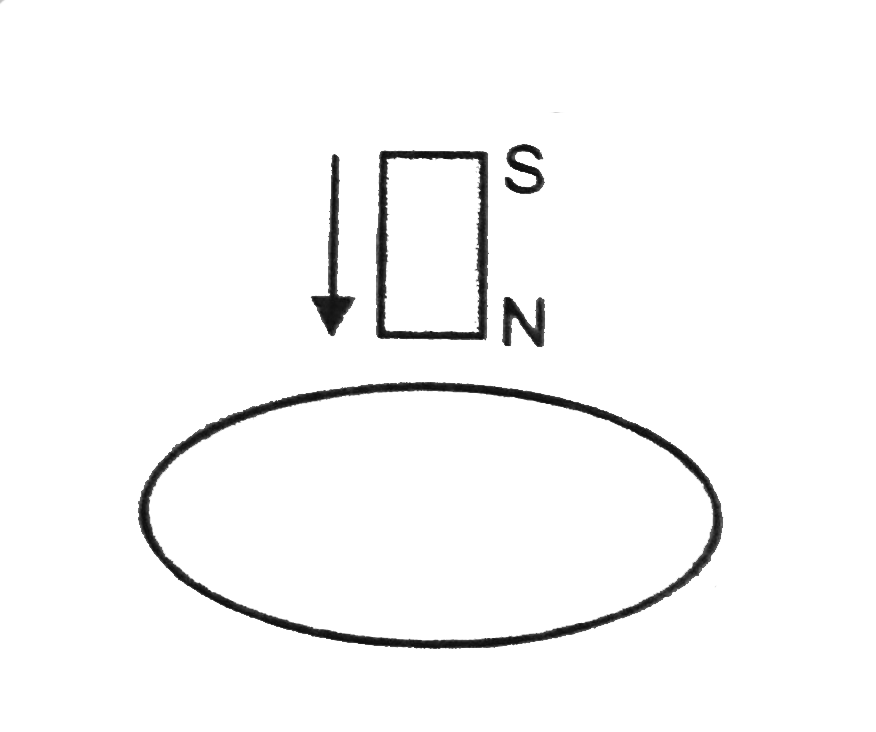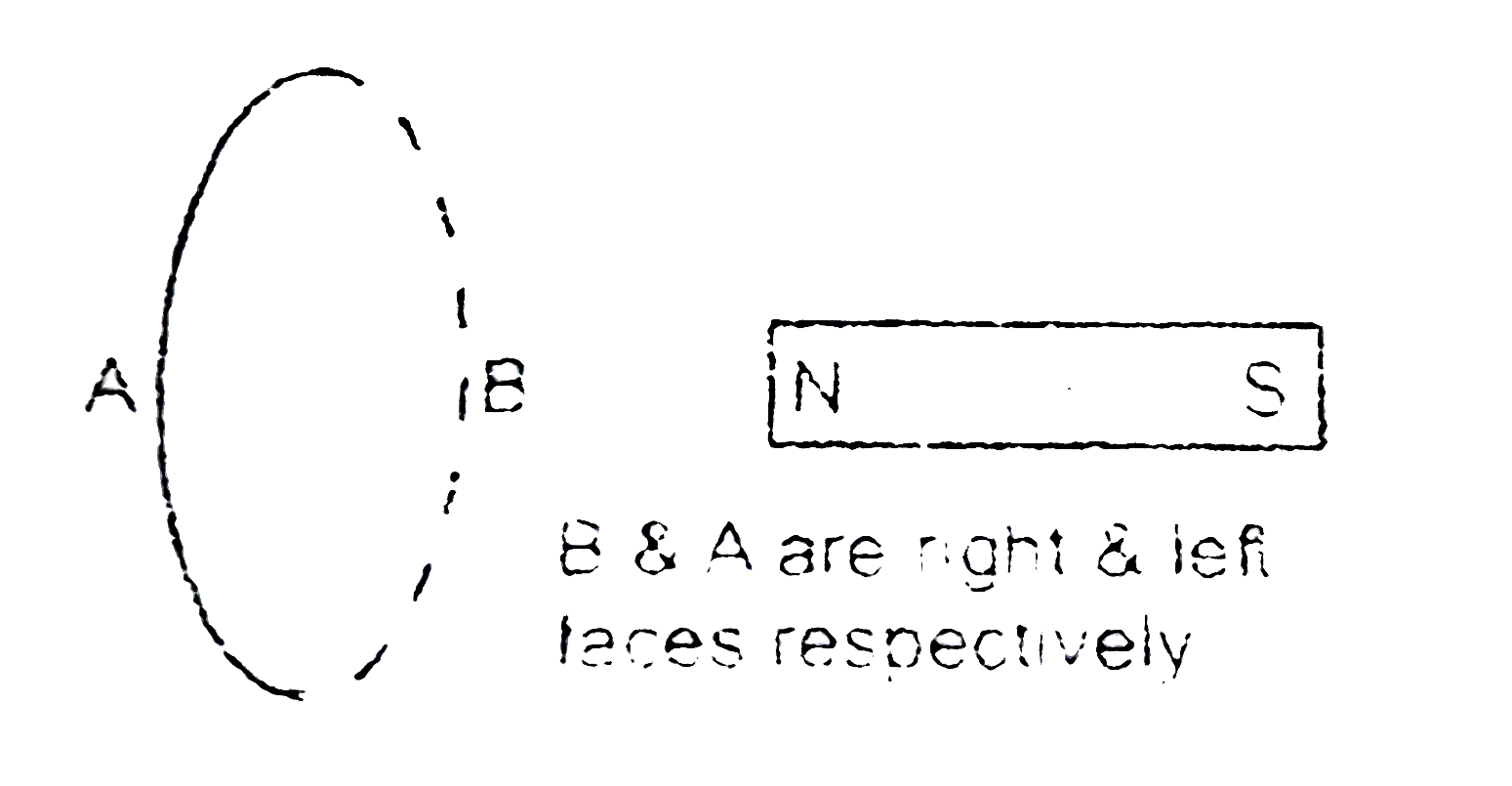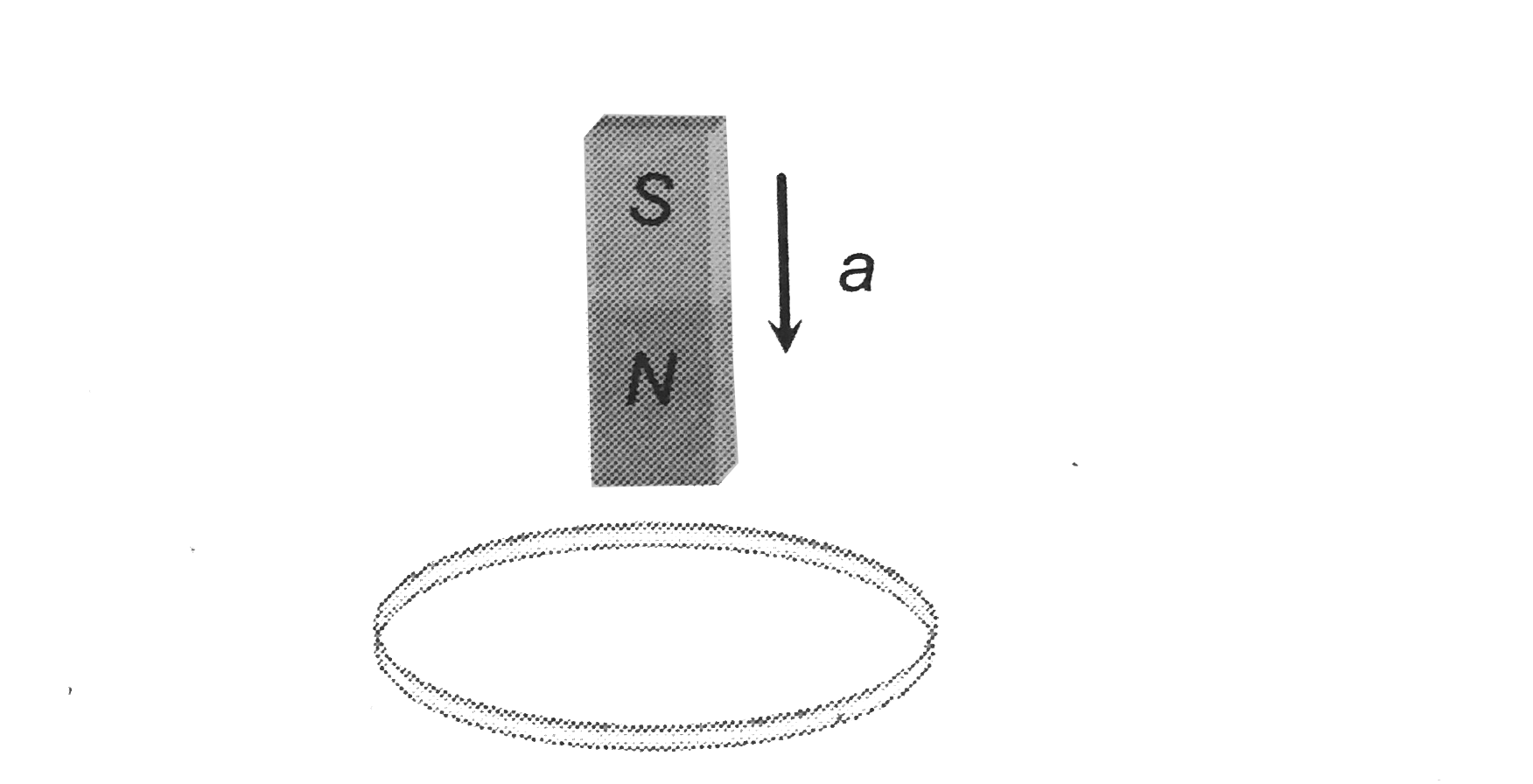A bar magnet is moved along the axis of a copper ring placed far away from the magnet. Looking from the side of the magnet, an anticlockwise current is found to be induced in the ring. Which of the following may be true?
The south pole faces the ring and the magnet moves towards it.
The north pole faces the ring and the magnet moves towards it.
The south pole faces the ring and the magnet moves away form it.
The north pole faces the ring and the magnet moves away form it.
The correct Answer is:B, C
To solve the problem, we need to analyze the situation where a bar magnet is moved along the axis of a copper ring and determine the conditions under which an anticlockwise current is induced in the ring.
1. Identify the Magnet's Orientation:
- We have a bar magnet with a North (N) and a South (S) pole. The problem states that the observer sees an anticlockwise current induced in the ring when looking from the side of the magnet.
2. Understand the Movement of the Magnet:
- If the North pole of the magnet is moving towards the ring, the magnetic field lines from the North pole are entering the ring. This causes an increase in the magnetic flux through the ring.
3. Apply Faraday's Law of Electromagnetic Induction:
- According to Faraday's law, a change in magnetic flux through a loop induces an electromotive force (emf) in the loop. Since the magnetic flux is increasing as the North pole approaches, an induced emf will be generated.
4. Determine the Direction of Induced Current Using Lenz's Law:
- Lenz's law states that the direction of the induced current will be such that it opposes the change in magnetic flux. Since the magnetic flux is increasing due to the approaching North pole, the induced current must create a magnetic field that opposes this increase.
5. Determine the Direction of the Induced Magnetic Field:
- To oppose the magnetic field due to the North pole (which points out of the ring), the induced current must create a magnetic field that points into the ring. The only way to achieve this is if the induced current flows anticlockwise when viewed from the North pole's side.
6. Conclusion:
- Therefore, if the North pole of the magnet is moving towards the ring, the induced current in the ring will be anticlockwise. This corresponds to option B being correct.
7. Consider the Alternative Situation:
- If the South pole of the magnet is moving away from the ring, the magnetic flux through the ring will decrease. According to Lenz's law, the induced current will then flow in such a way as to oppose this decrease, which would also result in an anticlockwise current.
8. Final Answer:
- Both situations where the North pole approaches the ring and the South pole moves away from the ring can lead to an anticlockwise current in the ring. Thus, options B and C are correct.
- We have a bar magnet with a North (N) and a South (S) pole. The problem states that the observer sees an anticlockwise current induced in the ring when looking from the side of the magnet.
- If the North pole of the magnet is moving towards the ring, the magnetic field lines from the North pole are entering the ring. This causes an increase in the magnetic flux through the ring.
- According to Faraday's law, a change in magnetic flux through a loop induces an electromotive force (emf) in the loop. Since the magnetic flux is increasing as the North pole approaches, an induced emf will be generated.
- Lenz's law states that the direction of the induced current will be such that it opposes the change in magnetic flux. Since the magnetic flux is increasing due to the approaching North pole, the induced current must create a magnetic field that opposes this increase.
- To oppose the magnetic field due to the North pole (which points out of the ring), the induced current must create a magnetic field that points into the ring. The only way to achieve this is if the induced current flows anticlockwise when viewed from the North pole's side.
- Therefore, if the North pole of the magnet is moving towards the ring, the induced current in the ring will be anticlockwise. This corresponds to option B being correct.
- If the South pole of the magnet is moving away from the ring, the magnetic flux through the ring will decrease. According to Lenz's law, the induced current will then flow in such a way as to oppose this decrease, which would also result in an anticlockwise current.
- Both situations where the North pole approaches the ring and the South pole moves away from the ring can lead to an anticlockwise current in the ring. Thus, options B and C are correct.
Topper's Solved these Questions
- ELECTROMAGNETIC INDUCTIONBOOK - HC VERMA ENGLISHCHAPTER - ELECTROMAGNETIC INDUCTIONEXERCISE - EXERCISE
98 Videos
- ELECTROMAGNETIC INDUCTIONBOOK - HC VERMA ENGLISHCHAPTER - ELECTROMAGNETIC INDUCTIONEXERCISE - Questions for short answer
9 Videos
- ELECTROMAGNETIC INDUCTIONBOOK - HC VERMA ENGLISHCHAPTER - ELECTROMAGNETIC INDUCTIONEXERCISE - Objective 1
11 Videos
- ELECTRIC FIELD AND POTENTIALBOOK - HC VERMA ENGLISHCHAPTER - ELECTRIC FIELD AND POTENTIALEXERCISE - Objective 2
7 Videos
- ELECTROMAGNETIC WAVESBOOK - HC VERMA ENGLISHCHAPTER - ELECTROMAGNETIC WAVESEXERCISE - Exercise
8 Videos
Similar Questions
A bar magnet is dropped along the axis of copper ring held horizontally. The acceleration of fall is
View SolutionA bar magnet is released from rest along the axis of a very long, vertical copper tube. After some time the magnet.
View SolutionThe magnetic field on the axis at a distance z from the centre of the bar magnet would be ?
View SolutionWrite down the IUPAC name of the following :

View SolutionA short magnet is allowed to fall from rest along the axis of a horizontal conducting ring. The distance fallen by the magnet in one second may be
View SolutionThe north of a bar magnet is moved towards a coil along the axis passing through the centre of the coil and perpendicular to the plane of the coil. The direction of the induced current in the coil when viewed in the direction of the motion of the magnet is
View SolutionAssertion. The bar magnet falling vertically along the axis of the horizontal coil will be having acceleartion less than g.
Resaon. Clockwise current induced in the coil.

View SolutionThe identical loops of copper and aluminium are moving with the same speed in a magnetic field. Which of the following statements true?
View SolutionIn the figure shown, the magnet is pushed towards the fixed ring along the axis of the ring and it passes through the ring.

View SolutionA metalic ring is attached with the wall of a room. When the north pole of a magnet is brought near to it, the induced current in the ring will be

View Solution
